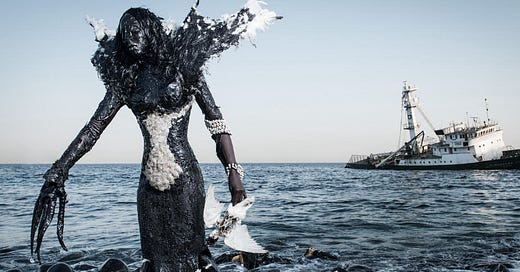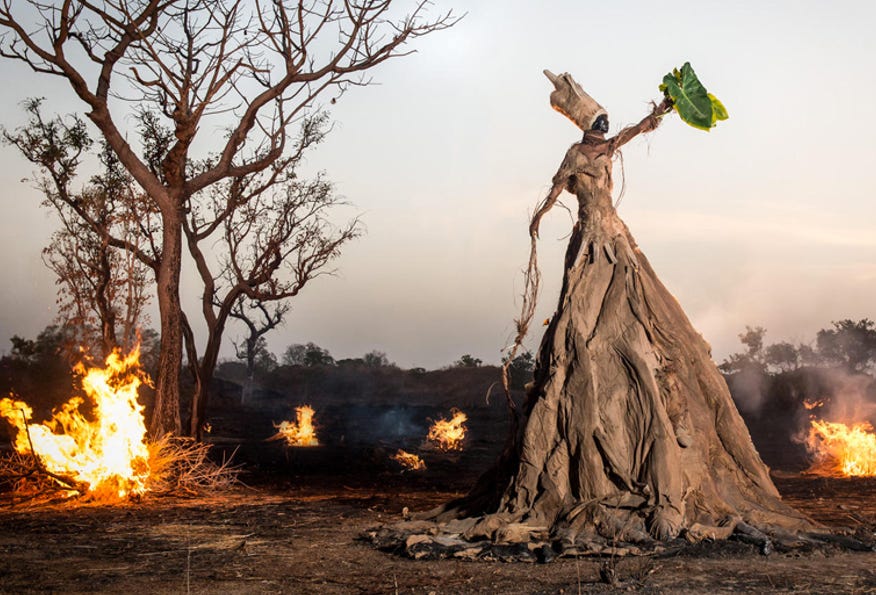Prophets and Djinns
What we can learn from ancient genies and the prophet Jeremiah amid ecological crises.
Hann Bay in Dakar, Senegal, was pristine and beautiful fifty years ago. It was one of the world’s great beaches. Now, it is one of the world’s most polluted beaches.
See images in this article in the journal Environmental Health Resources. If you visit that page and look at a map of Senegal, you’ll see that Dakar is at the western tip of Senegal and opens up to the ocean. In a period of fifty years, the population of Dakar exploded from half a million people to 2.5 million people. People started cramming into houses on streets so tight that even waste trucks couldn’t fit down them. Families had to pay for their waste services, and so many disposed of waste any way they could—by throwing it in the canal, or by hurling it directly into the bay.
Industry saw an opportunity. Around one hundred industries have moved in around Hann Bay in Dakar. The once-thriving communities gave way to food companies, a slaughterhouse, an oil refinery, and chemical companies. Now, blood from the slaughterhouse runs in the water. Vegetable oil from the food companies flows into the water. Oil and fecal matter blend together to form black, awful sludge. A paradise has become a wasteland. It’s informally known as “Trash Bay.”
Here is photographer Fabrice Monteiro’s photographic interpretation of Hann Bay:
Personal photo, Fabrice Monteiro, “African Art Against the State,” Williams College Musuem of Art, 2016.
Fabrice Monteiro is the photographer of three haunting and gorgeous images from a Williams College Museum of Art exhibition held in 2016 entitled “African Art Against the State.” This photograph was the second of ten in a series called Prophecy. In the photo above, we see a mysterious mutant-mermaid-bird creature rising up from the oil and garbage-strewn waters. Oil is constantly spilling in these waters because, in addition to the oil refineries, fishing boats such as the one we see in the background regularly impale themselves on rocks and leak thousands of gallons of oil.
Monteiro’s art crosses many cultures. His father is from Benin, his mother from Belgium, and he embraces a global sensibility in his work. He has a background in fashion photography and is a former model. The Prophecy series is a collection of ten carefully constructed images reflecting Senegal’s environmental crises. Each image required building an intricate set made up of materials found on site.
Personal photo, Fabrice Monteiro, “African Art Against the State,” Williams College Musuem of Art, 2016.
This one, Prophecy #1 (above), was taken in Dakar’s infamous Mbeubeuss (Mubus) landfill. This is such a large landfill that around 500-1,000 people live in the dump and eek out an existence through digging, scavenging, and trading garbage. We can see the mysterious figure emerging from the dump heap, which is made out of trash.
The next one, Prophecy #6 (above), was taken in Tambacounda, Senegal, about 450 kilometers inland from Dakar. This is an area facing a crisis of brushfires. According to the organization Ecofund, which partnered with Monteiro to create this Prophecy series, over 700,000 acres of forest and pasture lands are burned by brushfires in the area. The mysterious figure holds up the only remaining green.
Yet who are these striking, faceless, intriguing figures? This is where things get interesting.
These figures are Fabrice Monteiro’s modern interpretation of Islamic intermediary spiritual beings called djinn. Djinns are known in popular culture as genies through books like 1001 Arabian Nights or the famous Disney movie Aladdin.
We may know of djinn through their popularization as genies, but djinn are a profound part of Islamic and pre-Islamic Arab belief systems. Djinns are invisible spiritual beings, intermediary beings that dwell between heaven and earth, below the celestial realm, and above the material realm. They are different from angels and demons because they can serve both good and evil. They are sometimes messengers from heaven helping fulfill human destiny, but they can also be tricksters and tempters, having a will of their own. They go back and forth between the realms.
In pre-Islamic Arab cultures, djinn functioned originally as gods, as “kings of the unseen” realms, worthy of worship. When Islam emerged, it incorporated the belief in djinn, but told of the djinn’s collective conversion to worshipping Allah. Djinn lost their divine-like status in the development of early Islam. In this process, the Qur’an declared djinn inferior to humans and subservient to God.
Islam created an understanding of good and evil djinn. The djinn who converted to the worship of the one true God were the righteous, and the ones who did not were evil and awaited judgment. The Qur’an even has a chapter or surah dedicated to djinn, chapter 72, which tells of their conversion to monotheism: “Say, O Muhammad, It has been revealed to me that a group of the djinn listened and said, “Indeed, we have heard an amazing Qur’an.”
Part of what Fabrice Monteiro does in his “Prophecy” series reflects both the environmental crises of Senegal and the resources of local religion. Senegal is largely an Islamic country, with over 90% of the country estimated to be Muslim. Djinn are deeply embedded in Islamic tradition. In Monteiro’s photographs, we witness a modern interpretation of this ancient belief, djinn as faceless beings rising up, prophesying the truth about the earth’s suffering.
Islam is, of course, not the only religion that affirms the power of intermediary figures, spiritual beings between heaven, hell, and earth. In the Hebrew Bible, the prophets experienced direct access to God’s realm and communicated to rulers and residents the messages they heard in the divine secret places. Often, like Monteiro’s modern djinn, the Hebrew prophets sought to accentuate their divine message through symbolic actions involving their bodies. Isaiah walked around naked and barefoot for three years to symbolize how the Assyrian armies would lead the Ethiopians into slavery and exile. The prophet Ezekiel ate a scroll to symbolize his obedience to YHWH’s divine word. Jeremiah took an oxen’s wooden yoke upon himself to symbolize the inevitable rule of Babylonian imperialism.
The story of ancient Israel in the Hebrew Bible is one of a small, resource-rich country used as a chess piece by the great Empires, in Jeremiah’s case, the Babylonians and the Egyptians. In this context, the prophets like Jeremiah interpret international politics from a spiritual perspective. The whole political realm becomes interpreted through the lens of faithfulness to YHWH. The kings, like King Nebuchadnezzar, become agents of the divine will in the prophetic imagination. Israel’s political woes are often interpreted as punishment for failing to obey the covenant with God.
Jeremiah chapters 27-28 give us a window into a specific political moment. Jeremiah lived through the Babylonian siege of Jerusalem in 597 BCE. He saw his fellow priests, prophets, and cultural leaders carted away into exile. His heart had been broken.
Yet not everyone left the city into exile. The Babylonian king Nebuchadnezzar installed a puppet king named Zedekiah to continue ruling over the remaining Jews. But then a small rebellion in Babylon’s ranks broke out, which briefly distracted the Empire, and Egypt, on the other side of ancient Israel, started encouraging nearby people to revolt. A crack in the Empire’s united front was an opportunity for the opposing power. So a group of city-states gathered in Jerusalem in 594 BCE to strategize: Edom, Moab, Ammon, Tyre, and Sidon all came to consult with each other and King Zedekiah.
Jeremiah burst onto the conference with all the energy and passion of Corey Booker’s marathon protest speech. Jeremiah’s body and tools functioned as his objects of protest. His prophetic action was urgent grief intervention, warning his people to face the fact of their imminent collapse at the hands of the Babylonians. The word he heard from God to say to the assembled leaders is that God had already given the lands of Moab, Sidon, and neighboring states to King Nebuchadnezzar. In other words: “Quit kidding yourselves. Your defeat is already a done deal, because you’ve forgotten about the covenant, about justice, mercy, and compassion for the poor. You might as well face your impending exile or death and make it easier on yourselves.” You can see why Jeremiah was not a popular prophet in his day.
A rival court prophet named Hananiah sought to build political popularity and claimed he had heard the opposite message from God. “I have broken the yoke of the king of Babylon, and in two years I will bring back everything that was carried away in the exile” (Jeremiah 28:3). As if to say: Jeremiah is wrong. All is not doomed. In fact, liberation is at hand. So, Jeremiah and Hananiah had a prophetic showdown of sorts. On the one hand, Jeremiah was somewhat politically savvy: he perhaps avoided a dangerous confrontation by saying in front of everyone: “Amen, may it be so! May the Lord fulfill what you have prophesied” (Jeremiah 28:6). But then Jeremiah revealed his bedrock conviction: he returned with iron bars around his neck instead of simply the wooden oxen yoke to symbolize the total finality of ancient Israel’s doomed fate.
We do not wish to hear the voice of the djinn, the voice of the prophets, rising up from our defeat and our garbage. It is much easier to follow false prophets, such as Hananiah, who tell us amid crises not to worry and that all is well. But the voices of today’s djinn are as unpopular as Jeremiah was in his day. Theirs are not optimistic prophecies of a better, more positive future; instead, theirs are the prophecies of truth, the truth about what we are doing to our planet, about what authoritarian leaders do to democracy, what the consequences are, and what they will be if we continue on our current course.







Thanks for this one Mark. After my time at IBM I helped cofound a tech company focused on measuring environmental impacts of supply chains, and this one really resonated. I see the tragedy of Hann Bay as not merely ecological but sacramental. A beach that once mirrored the divine clarity of creation now reflects back our collective sin, a sludge of oil and blood and human indifference. The photographs of Fabrice Monteiro don’t document as much as they prophesy. His djinn rise from the filth not as specters of doom but as avatars of revelation. They are the unblinking eyes of the earth itself, forcing us to confront what we have made of paradise.
There is a great symmetry here with the Hebrew prophets. Jeremiah’s iron bars and Monteiro’s trash-born djinn speak the same language: the material world is never inert. It bears witness. It accuses. When blood runs in the water and sludge chokes the shore, these are not just environmental failures. They are spiritual indictments. The bay’s suffering is a mirror held up to our own desecration of the sacred.
And yet, there is something fiercely incarnational in this horror. The djinn, like the prophets, emerge from the very garbage we’ve discarded, as if to say “Holiness cannot be quarantined.” Even in the landfill, even in the oil-slicked bay, the divine refuses to abandon the material world. Monteiro’s art insists that the spiritual and the ecological are inseparable. The djinn are not abstract warnings. They are the earth’s cry, made flesh in recycled waste.
We prefer the Hananiahs of our age, the voices that soothe and deflect. But the true prophets, whether Jeremiah or Monteiro’s djinn, offer no such comfort. They stand knee-deep in the consequences of our choices and demand we face them. The question is not whether we will listen, but whether we will recognize these voices as what they are: sacred interruptions, calling us back to the covenant we’ve broken with the earth and, by extension, with the divine that pulses within it.